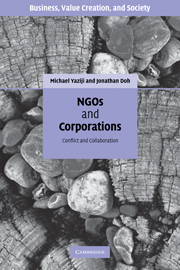Book contents
- Frontmatter
- Contents
- List of figures
- List of tables
- Preface
- Foreword
- Acknowledgments
- Part I Understanding NGOs
- 1 Classifying NGOs: definitions, typologies and networks
- 2 The emergence of NGOs in the context of business–government–societal relationships
- 3 The emergence of NGOs in the context of ethical and institutional complexity
- Case illustration: genetically modified organisms, social movements and NGOs
- Case illustration: protecting the people – environmental NGOs and TXU Energy
- Part II NGO advocacy campaigns
- Part III Corporate–NGO engagement
- Part IV The future of corporate–NGO relations
- Index
- References
Case illustration: genetically modified organisms, social movements and NGOs
Published online by Cambridge University Press: 13 January 2010
- Frontmatter
- Contents
- List of figures
- List of tables
- Preface
- Foreword
- Acknowledgments
- Part I Understanding NGOs
- 1 Classifying NGOs: definitions, typologies and networks
- 2 The emergence of NGOs in the context of business–government–societal relationships
- 3 The emergence of NGOs in the context of ethical and institutional complexity
- Case illustration: genetically modified organisms, social movements and NGOs
- Case illustration: protecting the people – environmental NGOs and TXU Energy
- Part II NGO advocacy campaigns
- Part III Corporate–NGO engagement
- Part IV The future of corporate–NGO relations
- Index
- References
Summary
The agricultural biotech (AgBiotech) industry – producing genetically engineered crop seeds – is young, having only become commercially significant in 1996. At that point, companies such as Monsanto, Aventis, Syngenta (created through a merger of the agricultural activities of Novartis and AstraZeneca), BASF and Dupont were becoming the primary producers of genetically engineered seeds. These seeds would soon be available worldwide and come in various forms. Herbicide tolerant plants, accounting for approximately 73 percent of global genetically engineered crop area, simply have structures that make crops more resistant to pesticides used commercially to control infestation. Insect resistant plants, accounting for approximately 22 percent of global genetically engineered crop area, are manufactured to produce pesticides within the plant as another way to deter infestation. “Stacked” plants are both herbicide tolerant and insect resistant. Other genetically engineered seeds include virus-resistant strains and added-nutrient crops, in which increased levels of vitamins or minerals can be measured. These product offerings aided in catapulting the industry from virtually nothing in 1995 to a $2.7 billion industry in 1999, and more than $4.75 billion in 2002. During this phase, analysts were singing the praises and the potential of the new industry. Companies in the industry and in the new broader “life sciences” category, which included pharmaceuticals, were rewarded with high multiples in their stock prices.
- Type
- Chapter
- Information
- NGOs and CorporationsConflict and Collaboration, pp. 46 - 49Publisher: Cambridge University PressPrint publication year: 2009



